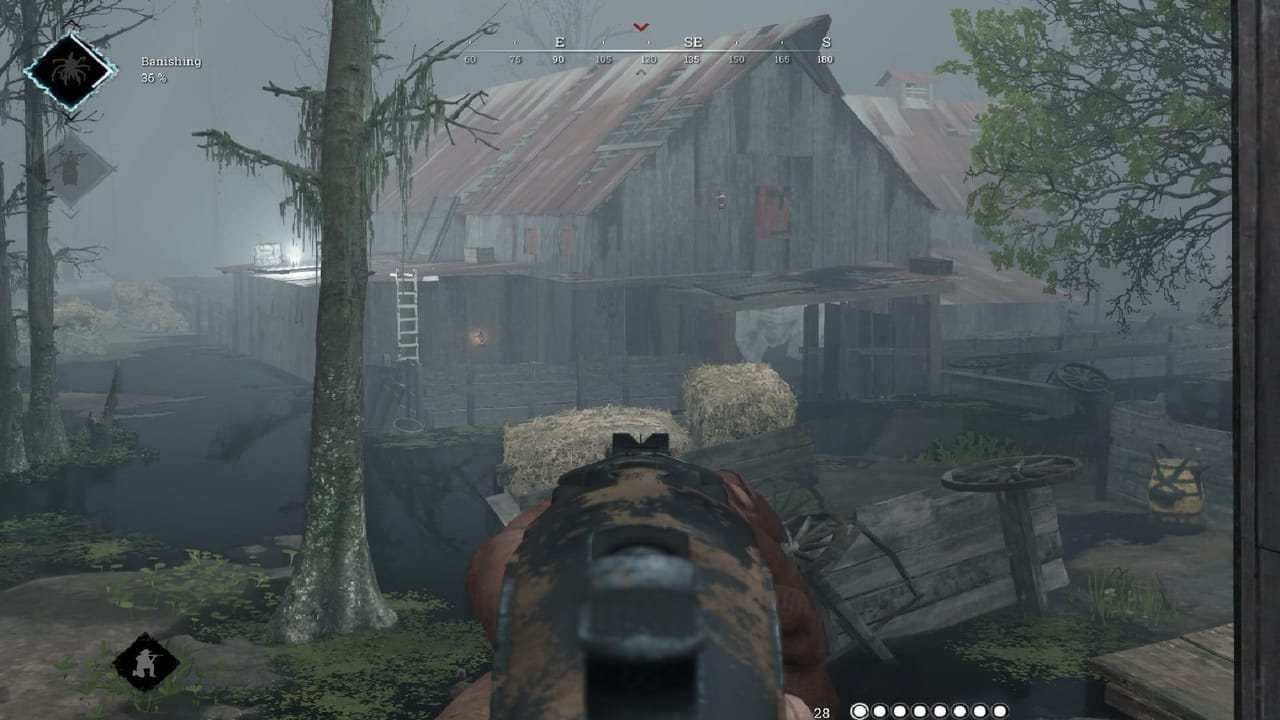I’ve long thought the battle royale genre would benefit from a blend of PVE and PVP. There’s a certain charm to fighting monsters, only to get blindsided by a random player. That style brings a lot of tension, perfect for a horror atmosphere. The folks at Crytek agreed and have spent the past two years getting Hunt: Showdown ready for the big world outside of Early Access.
You play a randomized bounty hunter exploring corrupted Louisiana swamps in the late 1800s. You’re charged with tracking boss monsters, killing them, banishing their physical form, and returning the bounty before someone takes it from you. Along the way, you’ll have to navigate bayous, crumbling buildings, and endless wheat fields.
The world map is probably Hunt: Showdown’s biggest strength. The playable area is enormous, and it can be difficult to get your bearings. The swamps are peppered with moss-covered cabins, collapsing mills, rotting farms, and defenses set by victims of the corruption. I’d call it a Lovecraftian post-apocalypse. You can almost feel the constricting humidity and the eminent dread.
Understanding Hunt: Showdown’s Core Gameplay

Hunt: Showdown has a fairly complicated gameplay loop. There’s a tutorial, but you can only play it once. To be honest, I struggled to fully understand the mechanics until I stopped to read the game manual front to back. There’s a lot of nuance to the enemies, the status mechanics, damage types, and your ability to interact with the world. You won't be aware of these things if you jump in unprepared.
The main mode is the Bounty Hunt. Alone or with a friend, you spawn on the edge of the zombie-infested swamps. A boss monster is hiding in a building somewhere on the map. You could stumble through the swamps until you find them, or you could investigate. Using magic sight, you can see the general direction of three clues in the distance. When you interact with a clue, your map shows you where the monster is not hiding. Practically, that means you can ignore the clues and go off toward the only boss-sized building that isn’t glowing blue.
Once you find and kill the boss, you start a ritual to banish the monster’s body. The ritual lasts three minutes and during this time, the other players (12 in each match) know where the boss died, which further invalidates the clue system. Complete the ritual and you can grab a “bounty token.” This is your meal ticket, so to speak. When you collect a token, other hunters can see a lightning storm over your head for the rest of the game. In exchange, you get 10 seconds of x-ray vision.
Once you have the token, you need to evacuate to a designated extraction point on the edge of the map. Upon reaching the escape boats, you need to hold out for 20 seconds. Death is permanent. When you die, you lose all your equipment and perk slots. However, you can evacuate to the boats at any time, with or without a bounty token.
Bounty Hunt’s biggest weakness is the lack of variety. After a good long while in Early Access, Hunt: Showdown only has three boss monsters, each with distinct weaknesses. This is especially noticeable because some matches include two bosses. Because there’s so little variety, high-level players can optimize their build for all boss types. Hunt: Showdown would really benefit from at least 3-5 more boss creatures to shake things up.
How Hunt: Showdown Tests Your Patience

There’s also Quick Play mode, although it’s not very quick. On average, I spent 2 minutes searching for a match, 1-2 minutes loading into the map, and another 2 minutes waiting for other players to load in. However, Quick Play has comparatively lower risk as you get a free level 1 hunter with a random weapon.
The goal is to interact with clues and take out the other hunters. Using a clue grants you a random perk for the rest of the match. The game ends when there’s only one player left. Quick Play is a more traditional battle-royale style mode, with the added tension of creatures and mutants lurking around every corner. If you win, you have a chance to keep your loadout and essentially earn a mid-level character in a few minutes.
Hunt: Showdown Wants You to Listen

Stealth is the preferred means of exploring the corrupted swamps. It was only when I started sneaking that I really appreciated the merging of sound design and gameplay. Hunt: Showdown has incredibly satisfying directional audio. Step on a stick and you’ll hear that distinctive crack. Running through swamp water has a much different sound than walking.
Enemies croak and wheeze when they’re alert. Surviving wildlife squak and whinny as you approach. Every sound is crisp and informs you of the situation. It’s fantastic at elevating the Lovecraftian horror atmosphere. At one point, I knew someone was shooting at me with a silenced weapon, so I took cover behind a boulder. I could hear my assailant marching up through the swamp water. I ran around the boulder and blasted him in the face with my shotgun. The sound design is effective at leveling the playing field between veterans and newcomers.
Hunt: Showdown’s Nightmarish Matchmaking

Unfortunately, the matchmaking system creates a massive divide between veterans and newbies. You can hunt solo, or in teams of two or even three. Partners can revive each other, but Solo players just get a slap from uncle permadeath. Even if you’re hunting solo, you’ll be playing against those coordinated teams. The game manual strongly advises new players against playing solo, so I tried out the “random partner” system. It did not turn out well.
I tried to play just one match with a random partner, and I failed colossally. In Hunt: Showdown, when you search for a random partner, both parties must accept the pairing. On top of that, both parties can see the other character's level and equipment load. Your accessible equipment is, of course, tied to overall account progression.
I look for a partner. A level 67 character with a legendary skin joins my lobby, sees that I’m a level 5, and leaves. Maybe I'm just the unluckiest player in the world, but I tried to get a random partner 30 times in a row before I gave up. I even came back after leveling up for another 20 spins at the machine. In total, I spent almost 20 minutes trying to find just one player who would give me a chance. However, because Hunt: Showdown lets you see the person’s stats before you play with them, they all left the moment they looked at my stat block. I couldn’t level up because I couldn’t find a partner and I couldn’t find a partner because I couldn’t level up.
Permadeath and Progression in Hunt: Showdown

In fairness, Hunt: Showdown allows you to succeed without winning. Killing mooks, hunting other players, and finding clues grants XP. You keep your rewards so long as you reach an extraction point, even if you didn’t kill the boss. This encourages low-level solo players to grind monsters and clues without going after the boss. It’s not fun, but it’s almost necessary. Grinding levels up your character (granting more perk slots) and your account level (which unlocks equipment).
Before treading through the swamp, you’ll need to swing by the in-game store. Here you buy weapons and consumables. Many options are locked behind level requirements or gaining kills with certain weapons. As a result, veteran players start with scoped rifles and traps while new players start out with noisy single shotguns and first aid kits. It gave me flashbacks to going against AK-47s in Modern Warfare 2.
Equipment loads carry over. If you use a healing syringe, it’s gone from your inventory forever. Likewise, if you manage to loot a high-level weapon off a dead hunter, you keep it until your character dies. Thankfully the store currency is abundant, and weapons are, usually, cheap.
While weapons are cheap, perks are not. You need to unlock perks through profile progression and perk slots through character leveling. When it’s time to select a new hunter, you get a lineup of four random characters. One is free but has the worst equipment and no perks. The others have slightly better equipment, consumables, and at least one perk. You can also use a premium currency to roll a new selection of hunters or remove and replace perks.
Hunt: Showdown Review | Conflicted

Hunt: Showdown leaves me on the fence. On the one hand, I completely understand why people love this style of battle royale. The boss monsters, mobs, and permadeath make for a uniquely engaging experience. Hunt: Showdown is one of the most “hardcore” multiplayer FPS games I’ve played. There are even more options for experienced players, like retiring high-level characters to level up faster. On the other hand, I struggle with the matchmaking, the unlock schedule, and permadeath.
At the end of my time with Hunt: Showdown, I found myself asking why I should play at all. It was fun for a while, but I wonder about its long-term potential. I’m not a big fan of grinding characters just to have the same equipment as veterans. Likewise, I personally don’t see the fun in grinding a character up for hours just to have them killed in one shot. It’s not just punishing; I’d argue it’s outright hostile to new players.
TechRaptor reviewed Hunt: Showdown on PC via Steam with a copy provided by the developer. The game is also available on PlayStation 4 and Xbox One.
Review Summary
Pros
- Unique Blend of PVE and PVP
- Incredibly Detailed Atmosphere
- Excellent Sound Design
- Fun Basic Enemies
- Horror and Dread
Cons
- Unfair Matchmaking
- New Players Severely Disadvantaged
- Long Waits for Quick Play
- Low Boss Variety
- Undermined Clue System
Have a tip, or want to point out something we missed? Leave a Comment or e-mail us at tips@techraptor.net













